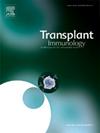白莫硫地尔成功治疗慢性眼移植物抗宿主病1例。
IF 1.4
4区 医学
Q4 IMMUNOLOGY
引用次数: 0
摘要
背景:Belumosudil是美国食品和药物管理局(FDA)批准的一种选择性ROCK2抑制剂,用于治疗至少两次系统性治疗失败的患者。Belumosudil通过抑制ROCK2,下调IL-21和IL-17的分泌,上调调节性T细胞(regulatory T cells, Tregs),起到减轻炎症反应的作用。此外,它可以通过抑制Rho-ROCK-MRTF通路,下调促纤维化基因表达和TGF-β信号传导,起到抗纤维化的作用。选择性抑制ROCK2还可减少m2样巨噬细胞和脉络膜新生血管,从而进一步发挥抗纤维化作用。因此,白莫硫地尔在治疗慢性移植物抗宿主病(cGVHD)方面显示出巨大的潜力。病例介绍:我们报告了一名患有严重进行性慢性眼部GVHD (oGVHD)的39岁男性患者的临床过程,口服白莫舒地尔后,患者的眼表损伤,包括角膜和睑板腺的损伤以及干眼症状均有显著改善。治疗后角膜白斑和新生血管明显减少。此外,白内障手术后患者的眼表症状保持稳定,没有恶化。患者的生活质量明显提高。结论:我们报告了一例慢性oGVHD患者使用白莫硫地尔治疗的临床结果。患者的临床症状明显改善,尤其是睑板腺炎症、角膜白斑和新生血管。这突出了其在cGVHD患者中的应用价值,为oGVHD患者提供了一种有希望的治疗选择。本文章由计算机程序翻译,如有差异,请以英文原文为准。
Successful use of belumosudil in a patient with chronic ocular GVHD: A case report
Background
Belumosudil is a selective ROCK2 inhibitor approved by the U.S. Food and Drug Administration (FDA) for the treatment of patients who have failed at least two prior systemic therapies. By inhibiting ROCK2, Belumosudil can down-regulate the secretion of IL-21 and IL-17, and up-regulate regulatory T cells (Tregs), which serve to attenuate the inflammatory response. In addition, it can act as an antifibrotic by inhibiting the Rho-ROCK-MRTF pathway, as well as down-regulating the expression of pro-fibrotic genes and TGF-β signaling. Selective inhibition of ROCK2 also reduces M2-like macrophages and choroidal neovascularization, which further exerts antifibrotic effects. Therefore, belumosudil shows great potential in the treatment of chronic Graft-Versus-Host-Disease (cGVHD).
Case presentation
We report the clinical course of a 39-year-old man with severe progressive chronic ocular GVHD (oGVHD), who showed significant improvement in ocular surface damage, including damage to the cornea and meibomian glands, as well as dry eye symptoms, after oral administration of belumosudil. Corneal leukoplakia and neovascularization were significantly reduced after treatment. Moreover, the patient's ocular surface symptoms remained stable without deterioration after cataract surgery. The patient's quality of life was significantly enhanced.
Conclusion
We report the clinical outcomes of a patient with chronic oGVHD treated with belumosudil. The patient's clinical symptoms significantly improved, especially inflammation of the meibomian gland, corneal leukoplakia, and neovascularization. This highlights its application value in patients with cGVHD and provides a promising treatment option for patients with oGVHD.
求助全文
通过发布文献求助,成功后即可免费获取论文全文。
去求助
来源期刊

Transplant immunology
医学-免疫学
CiteScore
2.10
自引率
13.30%
发文量
198
审稿时长
48 days
期刊介绍:
Transplant Immunology will publish up-to-date information on all aspects of the broad field it encompasses. The journal will be directed at (basic) scientists, tissue typers, transplant physicians and surgeons, and research and data on all immunological aspects of organ-, tissue- and (haematopoietic) stem cell transplantation are of potential interest to the readers of Transplant Immunology. Original papers, Review articles and Hypotheses will be considered for publication and submitted manuscripts will be rapidly peer-reviewed and published. They will be judged on the basis of scientific merit, originality, timeliness and quality.
 求助内容:
求助内容: 应助结果提醒方式:
应助结果提醒方式:


